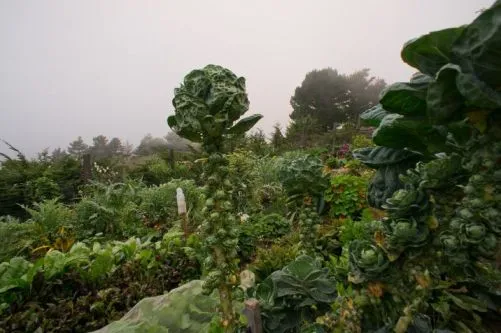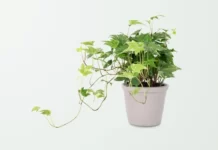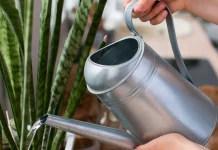The term Brussels sprout arises from Brussels. We all know what Brussels is, right? For those of you who are unaware, it is a city that is located in Belgium. In fact, it is Belgium’s capital. Apart from this, it is also the place of the European Union’s headquarters. Now, back to our sprouts. These Brussel Sprouts are bright green, and you can eat it in steamed or roasted form. The best part about these Brussels sprouts is that they are a complete package of fiber minerals and vitamins.
The Brussels sprouts come in a variety of their kind, with “Brigitte F1” being the most popular one. In fact, once planted you are bound to receive marvelous results when the growing season arrives. The main reason for it is that it allows more than one harvest for each growing season; they tend to be closed for longer time periods. Apart from being an excellent source of dietary fiber they also provide you with folic acid, vitamins C, and vitamin D.
They contain a component called “glucosinolates” which are known to be quite effective for cancer treatment.
Not sure how do Brussel sprouts grow? Do you not know how to harvest Brussels sprouts? How to grow Brussel sprouts in pots or how to grow Brussel sprouts from seed? Well, worry no more, as we are going to learn everything about Brussel Sprouts today!
From how to plant Brussel sprout seeds to how to pick Brussel sprouts – We have you covered!
How to Plant Brussel Sprouts?
Well, there are a few steps that are required to plant Brussels sprouts. We have mentioned all the important headers that are required for your knowledge to yield a good result.
Let us start! Keep in mind that there may be more than one way to plant and grow Brussel sprouts. Our method is the easiest and most cost-effective. It will also ensure a much greater yield than other methods.
Where Can Brussel Sprouts Be Planted?
Again, there are several areas where you can plan them. It all depends on the area you have. For instance, if you have a large house, we recommend that you dedicate a separate area to them. If not, you can even grow them in large flowerpots. But make sure that you choose a garden area that is exposed to ample sunlight for each specific day. You need a minimum of 6 to a maximum of eight hours of direct sunlight exposure for your plant. You can also opt for planting them in a greenhouse or simply in a shared house since it will be on a large scale and would yield a greater result.
Cold climate conditions are required for Brussels sprouts to grow since they are hardy in nature. This does not mean that they will not survive in warm areas or climates, however, to obtain optimum results it is best to grow them in wintertime. Make sure that plant staking takes place in autumn otherwise, the wind would blow the long stems over.
To plant these Brussels sprouts, you need to prepare the Earth’s soil for about four or 6 months, prior to the whole process, since they require nutritious and firm soil. It is what puts off many people. But we assure you that if you prepare the soil in the right way, you can ensure a good yield.
Preparing the soil for Brussels sprouts is like preparing for an exam. If you study throughout the year, you can ensure good grades. Likewise, if you dedicate enough time and resources to preparing the soil, your Brussel sprouts will be of top quality. The yield might be so much that you may even give it to your friends and family members.
How Can Brussel Sprouts Be Sowed?
You need to start off with your Brussels sprouts approximately four weeks prior to your planned date that would be in the second week of March. You can choose modular planting trays – with each module holding one seed.
With an inch of depth of the tray, you can plant your Brussel sprout seeds. You can expect the germination to occur in a week or in 12 days. Once germination ends, garden transplantation can take place for the seedlings (around a month later).
And to eat germination you can opt for a heat tray or a propagation system. However, make sure that the seedlings don’t turn out to be thin or long. You can pay more attention to the healthy seedlings while picking out the weaker ones.
How to Grow Brussel Sprouts? Top Tips
Well, now that you have learned how to plant them, next comes how to grow Brussel Sprouts along with a few caring tips and tricks for you to execute.
Let us skim through them!
How are Brussel Sprouts Watered?
Before garden transplantation occurs, make sure not to let your seedlings dry up. To keep the soil moist for the germination process make sure to use a spray misting bottle.
Although, you need to keep a check on its watering amount. A balance is required otherwise stunted growth and root rot can occur – a result of overwatering.
Once you have planted them, provide water and allow the soil to dry for a maximum of 2 or 3 days. This allows the roots to thoroughly grow as they tend to constantly search for water in the ground.
For warm climatic conditions, you need to provide water for your sprouts each day. On the contrary for a cold climatic area watering two times a week can allow optimal results.
Overwatering can also cause problems like soil water login for the root of a plant. So exaggeration will cause your Sprout root to rot and eventually result in plant death.
How Can Brussel Sprouts Be Hardened?
If Brussels sprouts are landed indoors then ample time should be provided for them to adjust to atmospheric conditions outside. You can also use a propagator or a plastic tent to cover the seedling tray which will retain an atmosphere filled with humidity and moisture.
Make sure to not expose the seedling tray to direct Sun. you can keep it inside during the night and in a shady cool area during the day. The hardening treatment is to be repeated for 10 consecutive days.
The plastic tent needs to be removed an hour before from the tray. Make sure you cut back time for each session by an hour considering that it no longer requires a pseudo greenhouse.
How Brussel Sprouts Are Transplanted?
Brussels sprouts have a large garden size and their root system tends to spread horizontally over the area. They come in different varieties a tall height which can reach up to 30 inches. Ample space in between Brussels sprout plants is required. A space of 25 inches is ideal.
Once you have landed your seedling a whole can be dug around it which should be one foot wide. Perlite can be added then for added nutrients.
The seedlings are to be placed in the center and to be slightly pressed in between the soil. This will remove all air pockets within. To prevent transplant stress thoroughly water the root ball of the plant, however, make sure that you are gentle.
What Kind Of Care Do Brussel Sprouts Require?
These types of plants require a pH controlled, well watered, fertile, and moist soil to grow with ample nutrients.
You can opt for organic fertilizers as they have the appropriate amount of nutrients that are required for the growing plant. Seaweed fertilizers and chicken manure are an ideal source of Potassium, Phosphorus, and Nitrogen for Brussel Sprouts.
A monthly feeding session for your plants is required along with parenting of the soil. Make sure that growing weeds don’t take over your garden area and spread along. You can fork the soil and create root aeration to promote growth.
Staking should occur in Autumn. Use a plastic or wooden 2 foot stake and start digging 2 inches from the plant base. The trunk should be loosely tied in this process.
Do Brussel Sprout Crops Require Rotation?
Brussel Sprout’s plant succession process is an excellent one but a high-yield result. You can start off the process around four weeks and have a successful harvest throughout winter and fall.
Although you may need to make sure of their plant rotation. For every season the growing site requires your plants to be rotated. This is probably because Brussels sprouts require plenty of ground nutrients and in order to provide them with it, rotation is required. In fact, you can also rotate them each year to prevent any pathogen infestation.
What Pests or Diseases Are Brussel Sprouts Prone to?
Despite being a hardy plant, Brussels sprouts are quite prone to pests and infections that can occur from neighboring plants present in the garden. A few common pests or diseases are listed below:
- Clubroot Disease
- Cutworms
- LeatherJackets
- Cabbage Caterpillars
- Cabbage Root Fly
You can use organic pesticides, for instance, neem oil to help with pest control. Make sure that the best spray is used at least 2 to 3 weeks prior to the process of harvesting.
How Can Brussel Sprouts Be Harvested And Stored?
Once the seeds of your Brussels sprouts stocks ripen this means that you can begin harvesting. The work basically begins at the bottom and goes up to the stop. In a span of a few days, your Brussels sprouts harvesting process can be completed. You need to make sure to pick out your Brussels sprouts when they’re well-ripe.
Make sure to get rid of yellow leaves otherwise, it can cause the plan to have a disease. Once your harvesting is complete, make sure that you do not rinse your Brussels sprouts. Instead, you need a Ziploc bag to pack them in and now store them away in a fridge. You can freeze them for approximately 6 months.
Short FAQs – Frequently Asked Questions:
How and when to harvest Brussel sprouts?
Once you witness green-colored tiny get from the heads of the Brussels sprouts, it indicates that they are ready to harvest. Make sure that they have a 1 or 2-inch diameter. You can twist these Brussels sprouts till they are separated from the base in order to remove them. Well, as you do so you can also get rid of the yellow leaves which will allow you to continuously grow more Brussel Sprout and leaves in an upward direction.
How to care for Brussel sprout plants?
A few essential steps are required to care for Brussels plants.
For instance, they require a neutral or slightly acidic soil and should be moist, fertile, and well-drained along with an apple source of organic fertilizers. Additionally, their roots require a good water supply of around one or maybe 1.5 inches each week.
To top it off, a humid and temperature control environment should be right for Brussel sprouts along with the use of high quality fertilizers.
How often to water Brussel sprouts?
You can water Brussels sprouts every week or even more at approximately 60.5 L or 1 inch or 60 gallons of water.
How do you know when Brussel sprouts are ready to harvest?
Brussels sprouts once are green and firm, which means they are ready to be harvested. They will also have a diameter of one or 2 inches.
How long does it take for Brussel sprouts to grow?
The approximate growing season for Brussels sprouts is around 80 to 100 days. If it takes too long, you might have planted them incorrectly.
How tall do Brussel sprouts grow?
Brussels sprouts can have a height of around 25 inches. It can often also lead to 30 inches of height.
How tall do Brussel sprouts get?
Brussels sprouts if placed properly that is 2 1/2 feet apart can fully mature the height of 24 inches up to even 36 inches.
How far apart to plant Brussels sprouts?
Being 1.5 inches deep, the seeds must be sown one-fourth to it. They should be 4 inches spaced apart if placed in a row. Once leafing occurs, they can have a 1 or 2-inch spacing between them. If you reduce the distance, they might not get the required sunlight or the space to grow properly. As a result, the quality and production will take a significant hit.
How many Brussels sprouts per plant?
If you are harvesting in a warm climate then you may result in two or maybe six Brussels sprouts in a time period of one or two weeks. The harvesting process is delayed by 3 to 4 weeks in winters and it can yield around 10 to a maximum of 15 Brussel Sprouts. However, there is no set number for the yield, but a maximum of 3 pounds per plant is expected on average. The exact yield is dependent on various factors like the amount of sunlight the plants are getting, soil, and the climate. Therefore, it is challenging to let you know the precise number of Brussels sprouts per plant.
How much sun do Brussels sprouts need?
Brussels sprouts need ample sunlight with direct exposure. A minimum of six hours with a maximum of eight hours of sunlight exposure is required for them. Without this much sunlight, the quality and the yield of the sprouts will suffer. Hence, all your effort will go to waste. Therefore, area selection is something that you must pay a lot of attention to, so that you can avoid problems later.
All in All
Hopefully, with the help of our guide, we are confident that you are now well equipped with a comprehensive knowledge of how to plant Brussels sprouts and how to grow Brussel Sprouts; along with a few other frequently asked questions that you may need for your assistance.
Well, let’s not waste any more time and let the planting begin!














